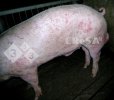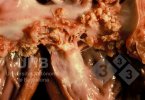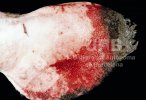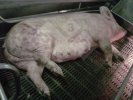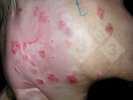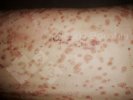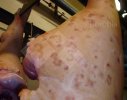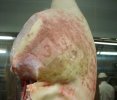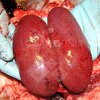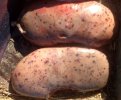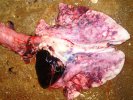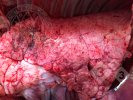Erysipela
Erysipelas is a systemic bacterial disease characterized by diamond shaped skin lesions and arthritis in its chronic forms.
Information
It is a frequent disease caused by a bacteria called Erysipelothrix rhusiopathiae found in most farms. It is estimated that up to 20% of healthy animals carry the organism in the tonsils, and it is eliminated through feces or saliva, thus, this is the way the disease maintains a low infection level in the environment. It also can be found in many other species, including birds (especially turkeys) and sheep, and can survive outside the pig for a few weeks, mainly in flooring where sand is used as bedding. Infected feces are probably the main source of infection, mainly in growers and finishers.
The disease is not very common in pigs 8 to 12 weeks old or less due to the protection provided by maternal antibodies in colostrum. The more susceptible animals are growing pigs, gilts and not vaccinated sows and boars.
The bacteria invades the blood stream through different ways including skin lesions or through the digestive tract’s wall, producing septicemia. The incubation period is 24 to 48 hours. Disease tends to be sporadic and is more prominent in warm weather (summer).
Symptoms
Boars
- High fever.
- Sperm can be affected during all the development period, which lasts 5 to 6 weeks.
Sows
Hyper-acute and acute disease
- Death, general infection.
- High fever.
- Might look normal.
- Abortions.
- Mummified piglets.
- Characteristic skin lesions that look like skin eruptions of 10 to 50 mm, and diamond shaped all over the body that can change from red to black.
- Pigs do not want to wake up and are rigid, indicating joints infection.
- Sudden death is frequent due to acute septicemia or heart failure.
Sub-acute disease
- Loss of appetite.
- Infertility
- Characteristic skin lesions.
- Temperature variations.
- The disease can be so mild, it goes undetected.
- Some piglets die in the uterus after a sub-acute infection and are mummified.
Chronic disease
- May or may not be present after the acute or sub-acute disease.
- Affects joints producing lameness or chronic arthritis and swollen that can be responsible for condemnation at the slaughterhouse.
- Heart valves can be affected, which lead to an increase of the heart’s size, and ultimately heart failure.
Lactating piglets
- Not common in piglets
Weaners and growers
Acute disease:
- Sudden death.
- High fever.
- Characteristic skin lesions diamond shaped all over the body that can change from red to black.
Sub-acute and mild disease:
- It is the most frequent form of the disease.
- Might present skin lesions, but the pig does not look ill despite having fever.
- Might affect joints producing chronic arthritis and swelling.
Chronic disease
- Swollen joints.
- Lameness.
Causes / Contributing Factors
- Comingling of pigs.
- Hot summer weather with high humidity.
- Liquid feeding, mainly if milk- derived products are used, which can be an important source of infection because the microorganism reproduces in them.
- Barns continually used that do not follow the all-in/all-out system and are not disinfected.
- Water supply systems that may get contaminated.
- Common in systems that use stray bedding.
- Pigs exposed to contaminated soil.
Diagnosis
- Clinical signs especially diamonds skin lesions.
- Bacterial culture.
- PCR.
- Serology only indicates exposure and not disease.
Control/Prevention
- The organism is very sensitive to penicillin.
- In individual outbreaks of finishing pigs, the pens must be cleaned and disinfected between lots.
- In case of continuous outbreaks in the growing area, it might be necessary to vaccinate the pigs at 8 weeks of age, and possibly revaccinate at 10 to 12 weeks of age. Usually, pigs do not get vaccinated before 8 weeks of age because colostrum antibodies reduce the response to the vaccine.
- Vaccinate replacing gilts.
- Vaccinate the breeding herd (including boars) every six months.

